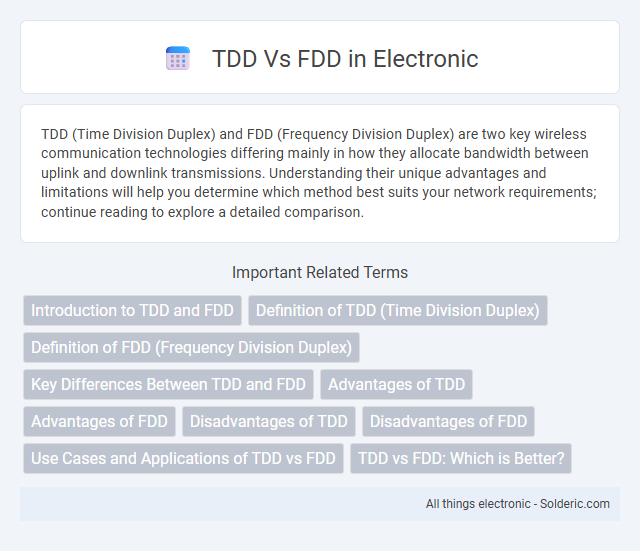TDD (Time Division Duplex) and FDD (Frequency Division Duplex) are two key wireless communication technologies differing mainly in how they allocate bandwidth between uplink and downlink transmissions. Understanding their unique advantages and limitations will help you determine which method best suits your network requirements; continue reading to explore a detailed comparison.
Comparison Table
| Feature | TDD (Test-Driven Development) | FDD (Feature-Driven Development) |
|---|---|---|
| Focus | Writing tests before code implementation | Designing and building features incrementally |
| Approach | Test-first, iterative development | Feature-centric, model-driven development |
| Primary Goal | Ensure code correctness and quality | Deliver working software features rapidly |
| Process Style | Developer-centric, coding and testing | Team-centric, planning and feature tracking |
| Documentation | Minimal, tests serve as documentation | Detailed design and feature lists |
| Best Suited For | Small to medium-sized projects, high quality focus | Large-scale projects with clear feature sets |
| Testing | Automated unit tests integrated continuously | Testing focused at feature completion |
| Iteration Length | Short, quick cycles (minutes to hours) | Longer, feature-based cycles (days to weeks) |
Introduction to TDD and FDD
Time Division Duplex (TDD) and Frequency Division Duplex (FDD) are essential duplexing techniques used in wireless communication to facilitate two-way data transmission. TDD separates uplink and downlink signals by allocating different time slots on the same frequency band, optimizing spectrum efficiency for asymmetric traffic. FDD employs separate frequency bands for uplink and downlink, providing continuous transmission and reception, often preferred for balanced and latency-sensitive applications in 4G and 5G networks.
Definition of TDD (Time Division Duplex)
Time Division Duplex (TDD) is a communication method that uses the same frequency band for both uplink and downlink transmissions, separated by different time slots to avoid interference. TDD dynamically allocates time between sending and receiving data based on network demand, enhancing spectral efficiency in variable traffic scenarios. Your choice between TDD and FDD depends on specific network requirements, including traffic asymmetry and spectrum availability.
Definition of FDD (Frequency Division Duplex)
Frequency Division Duplex (FDD) is a communication method that uses separate frequency bands for uplink and downlink transmissions, enabling simultaneous two-way communication without interference. FDD is widely employed in cellular networks such as LTE and 5G to provide consistent, low-latency connections and higher spectral efficiency. Your network performance can benefit from FDD by reducing signal delays and improving overall capacity during data transmission.
Key Differences Between TDD and FDD
TDD (Time Division Duplex) and FDD (Frequency Division Duplex) differ primarily in how they allocate spectrum for uplink and downlink transmissions. TDD uses a single frequency band divided into time slots for both transmission directions, enabling dynamic adjustment of uplink and downlink ratios based on traffic demands. FDD employs separate frequency bands for uplink and downlink, offering continuous transmission in both directions but requiring paired spectrum allocation.
Advantages of TDD
Test-Driven Development (TDD) improves software quality by ensuring code is thoroughly tested before implementation, reducing bugs and enhancing maintainability. By writing tests first, developers gain clearer requirements and faster feedback cycles that streamline debugging and refactoring processes. Your development team benefits from increased confidence in code stability and accelerated delivery of reliable software products.
Advantages of FDD
Frequency Division Duplexing (FDD) offers the advantage of simultaneous two-way communication by using separate frequency bands for uplink and downlink, which reduces latency and enhances real-time data transmission. Its continuous transmission capability makes FDD ideal for services requiring stable, symmetric bandwidth, such as voice calls and video conferencing. Your network can benefit from FDD's efficient spectrum usage in scenarios where paired frequency bands are available, leading to improved overall performance.
Disadvantages of TDD
Test-Driven Development (TDD) can lead to slower initial development as writing tests before code requires extra time and effort. It may result in overemphasis on unit tests, potentially neglecting integration and system testing, which affects overall software quality. TDD demands a high level of discipline and experience from developers, making it challenging for teams with limited testing expertise or tight deadlines.
Disadvantages of FDD
Frequency Division Duplex (FDD) faces disadvantages such as inefficient spectrum utilization due to the need for paired frequency bands, limiting flexibility in allocating uplink and downlink resources. FDD systems are less effective in asymmetric traffic scenarios, where uplink and downlink data rates significantly differ, leading to underutilized spectrum in one direction. The complexity and cost of implementing filters and duplexers to separate simultaneous transmit and receive signals further challenge the deployment of FDD technology in modern wireless systems.
Use Cases and Applications of TDD vs FDD
Time Division Duplexing (TDD) is favored in dynamic spectrum environments and asymmetric data traffic scenarios like 5G networks, where uplink and downlink demands vary significantly. Frequency Division Duplexing (FDD) is commonly used in traditional cellular networks and applications requiring consistent, simultaneous uplink and downlink transmission, such as LTE and early 4G deployments. TDD applies effectively in unpaired spectrum bands and environments with fluctuating traffic patterns, while FDD excels in paired spectrum bands with stable traffic symmetry.
TDD vs FDD: Which is Better?
TDD (Time Division Duplex) and FDD (Frequency Division Duplex) each offer specific advantages depending on deployment scenarios and spectrum availability. TDD enables dynamic allocation of uplink and downlink bandwidth, making it ideal for asymmetric traffic patterns in environments with limited spectrum. FDD provides simultaneous uplink and downlink channels, offering lower latency and better reliability in license-restricted bands with paired frequencies.
TDD vs FDD Infographic

 solderic.com
solderic.com